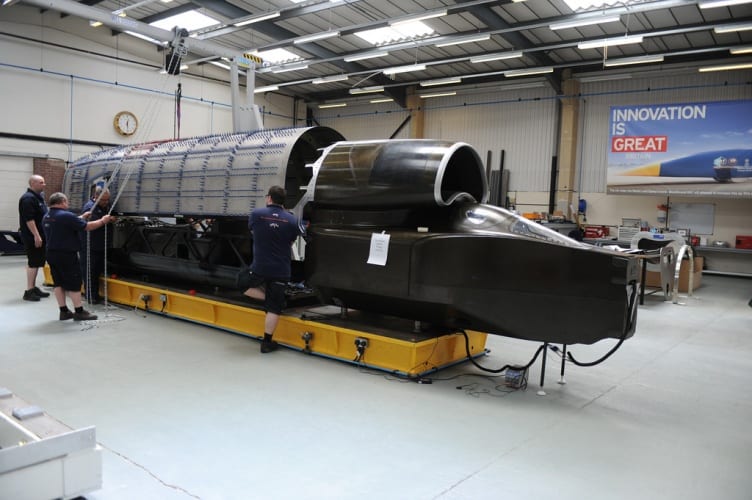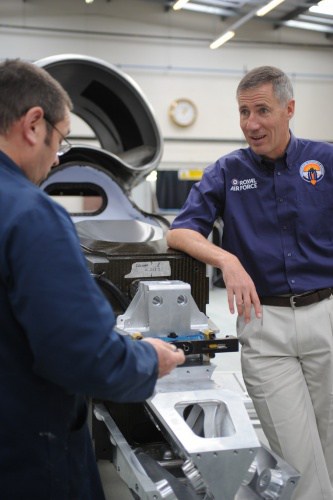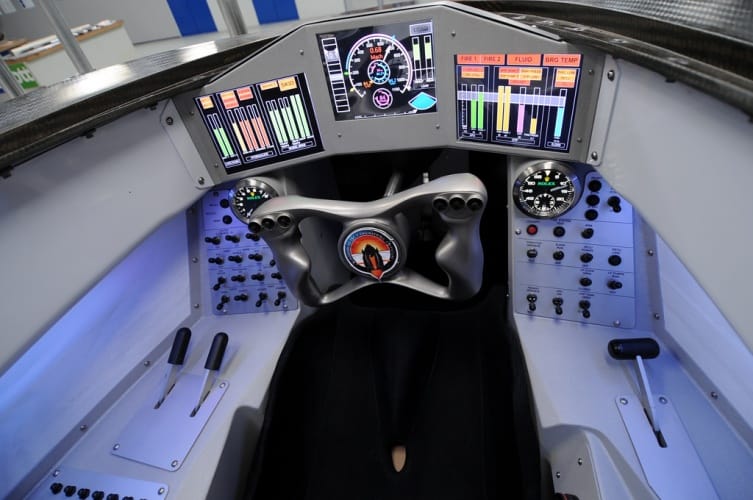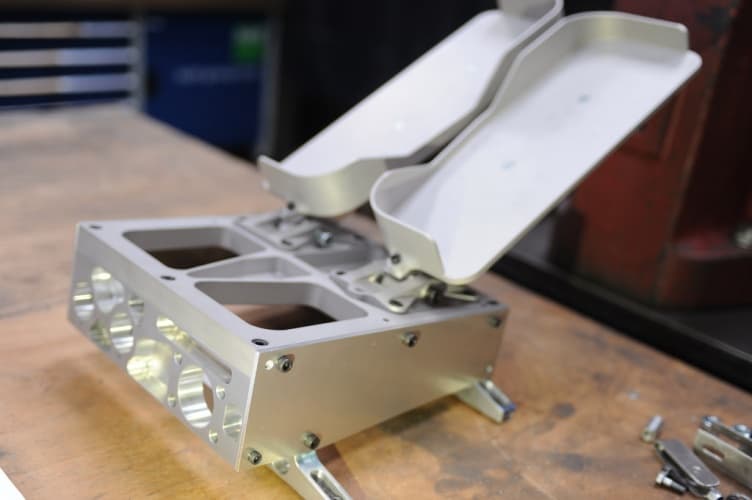Inevitably, the headquarters and technical centre for the UK project to travel at 1000mph at ground level takes self-effacement to an extreme level: it’s in an anonymous building, without even a sign to identify it, on a common-or-garden industrial estate just outside Bristol. The builders’ merchant next door has more to identify it. Even the local taxi-drivers are puzzled.
But inside, there’s no disguising that something extraordinary is taking shape here. The hangar-like space is divided in two by the raised shed-like structure that will act as Mission Control for Bloodhound’s record attempt runs in the South African desert, currently scheduled for 2015 and 2016. In front of this sits the consoles and housing, cannibalised from a nuclear submarine, for the mission control crew, awaiting the installation of three display screens and intercom equipment; and next to this is the XJ200 turbojet engine which will propel Bloodhound from a standing start to about 600mph.
To the right is the now-familiar purple shape of the Bloodhound show-car, emblazoned with the all-important sponsors’ logos and now sporting the latest design of tailplane (although it’s somewhat shorter than the real thing, otherwise it wouldn’t be able to get into schools and colleges; the actual tailplane is currently in manufacture).
To the left is the workspace, dominated by the bulk of the car itself, now about half-complete. With its skin held on by a myriad of ‘skin-pins’ screwed through the rivet-holes drilled through the curved titanium panels, its long, curved snout and air of quiet watchfulness, it calls to mind a high-tech sculpture of some bizarre spined animal; a giant ice-age ancestor of the porcupine.

The animalistic comparisons continue at Bloodhound’s nose, to which a chunky piece of stainless steel is bolted. This will support the front suspension and steering mechanisms, and is known to the crew as ‘the goat’s skull’. Moreover, the car’s canopy, sitting on a table nearby, is long, curved and comes to a sweeping point, with oval windows set into the sides of its dark carbon-fibre rounded rear edge. It strongly resembles the head of a raven, scaled up to enormous proportions. It’s all functional, though; the curve of the canopy has been carefully designed to create a standing shockwave at just the right point to slow the airflow down to the optimal velocity to enter the EJ200’s air intake.
The man whose head this avian sculpture will protect is much in evidence. The long-legged, languid frame of the world’s fastest man, Wing Commander Andy Green, is draped over the nose of the car giving guided tours of what he endeardingly refers to as ‘his office’ — the freshly fitted-out cockpit of Bloodhound, nestled within the carbon–fibre monocoque front section of the car, just below the gaping maw of the jet engine’s air intake. Removing his incongruous loafers, Green settles himself into the driving seat, places his feet where the control pedals will go and grasps the 3D-printed titanium steering wheel. ‘It’s a bit cosy,’ he says, wriggling his shoulders into the seat padding (custom moulded to his body shape), ‘but less cramped than a jet fighter. It has all the space we need, all the space I need to operate the controls, plus I have a clear eye-line and headroom to the canopy. It’s a big change from Thrust SSC.’

Indeed, Green’s former vehicle, which shattered the sound barrier on land in 1997, looks positively antiquated in comparison with its younger brother. The design philosophy for Thrust was to use tried-and-trusted off-the-shelf technology whenever possible, and its cockpit was a mass of analogue dials and shivering needles; one reason that Bloodhound’s steering wheel is titanium is that Green snapped Thrust’s while trying to correct the vehicle’s juddering drift as it went supersonic. On Bloodhound, meanwhile, the team is consciously trying to break new ground at every step.
Bloodhound does have two analogue instruments, set on either side of Green’s knees: on the left, a speedometer calibrated to 1.100mph, and on the right a chronograph with built-in stopwatch. Custom-built by Rolex to withstand the extreme vibration the car will experience, they are there to act as back-ups to the main digital instrument panel on the dashboard above the wheel.

The cockpit layout was designed to Green’s specifications. ‘I started with the speedo, which also has other functions; it took me about a year,’ he says. ‘It also shows distance and time. The red, blue and green diamonds around the outside edgeshow when I have to trigger the rockets, airbrakes and parachute, and the last two are measured in distance from the end of the track, but that’s related to the speed; so the car continuously computes that and displays it as a function of speed on the same instrument. So when the needle hits the yellow diamond, I hit the button to deploy the parachutes and I know the car will stop in the right place. I don’t have to do monitor the position and work it out in my head — I’ll be busy enough steering the car — and I know I’ll be in the correct position to turn the car round so the recovery crew can refuel and everything for the next run.’
Other displays show the jet engine conditions, chamber pressure for the rocket – which is essentially thrust – and the revs for the F1 Cosworth engine which powers the pump that squirts high-test peroxide fuel into the rocket motor. Wheel loads are also shown and are vitally important: too high or too low are instant determinants to abort a run. Power system toggle switches are on one side; hydraulics and braking on the other. ‘It’s very simple, because it can get very busy in here,’ Green said.

Busy, and hot and loud. The jet engine, rocket cluster and auxiliary F1 engine together generate 140db of noise, while the wind and vibration from the desert floor will make the two minutes of a record run — during which the car will travel 12 miles — an uncomfortable place to be. Even though the team will avoid the hottest part of the day, running in about 25°C conditions, it’ll reach some 35°C inside the cockpit; by contrast, while preparing the car before sun-up the cockpit will be sub-zero.
Bloodhound’s current schedule will see the car complete by the end of this year, when it will undergo runway tests in the UK next spring. The team will then depart for Hakskeen Pan in South Africa around July for Phase 1, when they will attempt to break the landspeed record. They will then return to the UK to overhaul the car and make any modifications indicated by those initial supersonic runs, intending to return to Hakskeen in 2016 to attempt to break the 1000mph mark.
It won’t be the fastest office in the world — that honour would go to the fighter aircraft that constitute Andy Green’s day-job — but for a couple of minutes in 2016 and 2017, it’ll be the fastest office on the face of the Earth.




JLR teams with Allye Energy on portable battery storage
This illustrates the lengths required to operate electric vehicles in some circumstances. It is just as well few electric Range Rovers will go off...